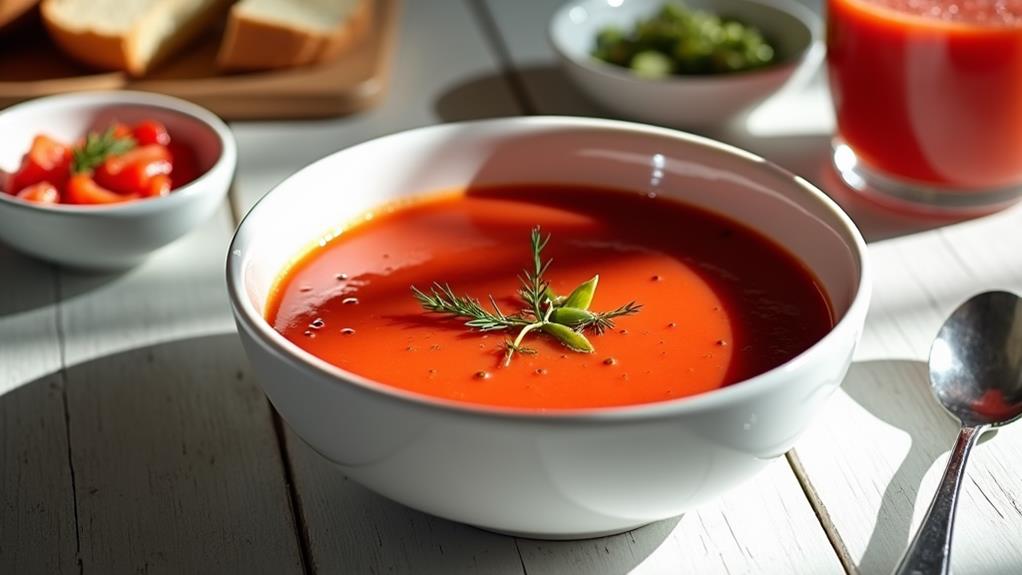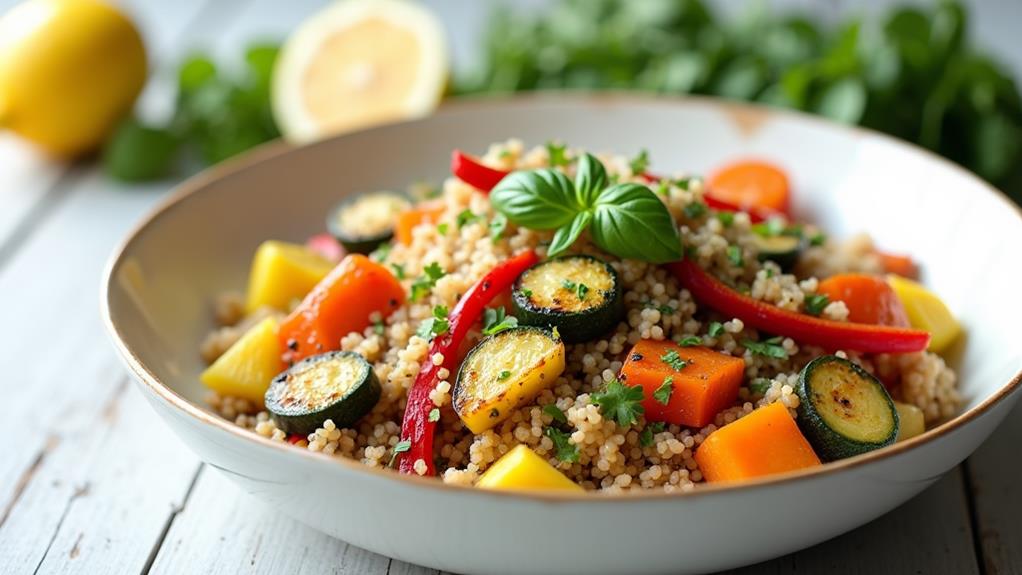You've likely encountered gazpacho on a restaurant menu or heard it mentioned as a refreshing summer dish. But do you know the rich history and culinary artistry behind this classic Spanish soup? While it may seem simple at first glance, gazpacho's evolution from ancient Roman roots to its current iconic status is a fascinating journey. As you consider the interplay of ripe tomatoes, crisp cucumbers, and aromatic garlic, you'll discover there's more to this cold soup than meets the eye. Let's explore the depths of flavor and tradition that make gazpacho a beloved staple of Mediterranean cuisine.
Key Takeaways
- Classic Gazpacho is a cold Spanish soup originating from Andalusia, made primarily with ripe tomatoes, cucumbers, and garlic.
- The recipe emphasizes fresh ingredients and typically includes olive oil and sherry vinegar for authentic flavor.
- Preparation involves blending vegetables until smooth, then straining for a velvety texture.
- Chilling for at least two hours is crucial for optimal flavor development and refreshing taste.
- Gazpacho is traditionally served in chilled bowls as a starter, offering nutritional benefits and make-ahead convenience.
History
While the exact origins of gazpacho are disputed, it's believed to have emerged in Andalusia, Spain, during the 8th century. The dish's roots can be traced back to Roman times when field workers would crush bread, garlic, and olive oil in a mortar to create a filling meal.
As the Moors introduced new ingredients to the Iberian Peninsula, tomatoes and peppers were incorporated into the recipe, evolving it into the gazpacho we know today.
You'll find that gazpacho's popularity spread throughout Spain and Portugal, with each region developing its own variations. In the 19th century, the soup gained international recognition as travelers discovered its refreshing qualities.
Today, you can enjoy gazpacho in countless restaurants worldwide, and it's become a staple of Spanish cuisine.
When you make gazpacho at home, you're participating in a centuries-old culinary tradition. The dish's enduring appeal lies in its simplicity and adaptability.
As you blend your ingredients, remember that you're crafting a soup that has nourished generations and continues to evolve with modern tastes and techniques.
Recipe
Gazpacho, a refreshing Spanish cold soup, is the perfect antidote to sweltering summer days. This no-cook dish originated in Andalusia but has since gained popularity worldwide for its simplicity and vibrant flavors.
This classic gazpacho recipe showcases the natural taste of fresh vegetables, creating a smooth and invigorating soup that captures the essence of Mediterranean cuisine. By blending ripe tomatoes with crisp cucumbers and a touch of garlic, you'll create a delightful dish that's both easy to prepare and bursting with flavor.
- 4 large ripe tomatoes (about 2 lbs or 900g)
- 1 cucumber (about 8 inches or 20 cm)
- 2 cloves of garlic
- 1/4 cup (60 ml) extra-virgin olive oil
- 2 tablespoons (30 ml) sherry vinegar
To prepare the gazpacho, roughly chop the tomatoes and cucumber. Add them to a blender along with the peeled garlic cloves, olive oil, and sherry vinegar. Blend the mixture until smooth, then taste and adjust the seasoning if needed.
For a silky texture, strain the soup through a fine-mesh sieve. Chill the gazpacho in the refrigerator for at least 2 hours before serving.
For the best results, use the ripest tomatoes you can find, as they'll provide the sweetest flavor. If the soup is too thick, you can thin it with a little cold water or tomato juice. Gazpacho can be stored in the refrigerator for up to 2 days, making it an excellent make-ahead dish for summer gatherings or quick lunches.
Consider garnishing with diced vegetables, croutons, or a drizzle of olive oil for added texture and visual appeal.
Cooking Steps
To make classic gazpacho, you'll follow a few simple steps that bring out the best flavors of fresh vegetables.
Start by washing and prepping your tomatoes and cucumber, then blend them with garlic, olive oil, and sherry vinegar until smooth.
For a silky texture, strain the mixture through a fine-mesh sieve, then chill it in the refrigerator for at least two hours before serving in pre-chilled bowls.
Step 1. Wash and Prep Vegetables
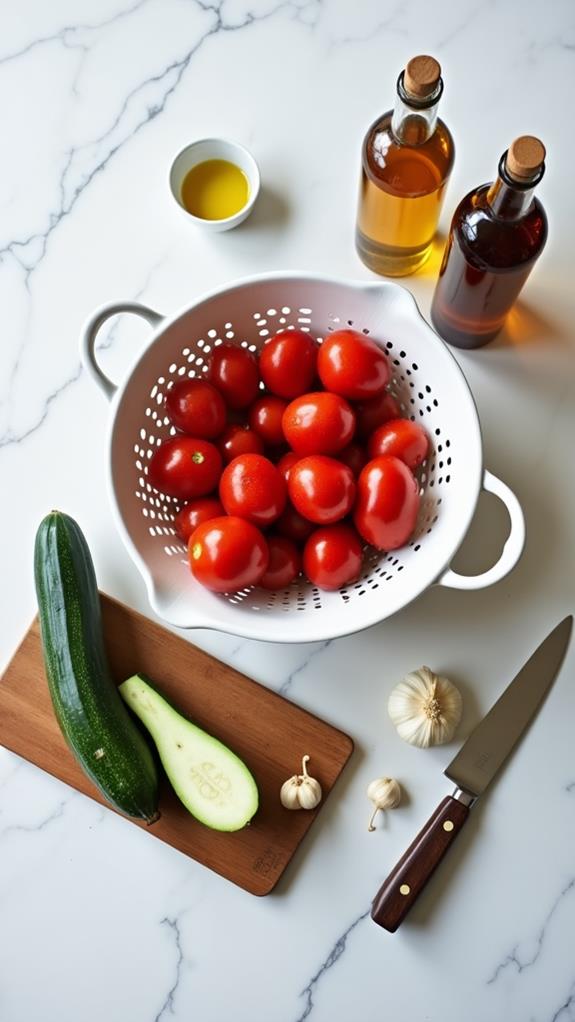
Ready to start your gazpacho journey? Begin by gathering your ingredients: four large ripe tomatoes, one cucumber, two garlic cloves, olive oil, and sherry vinegar.
First, wash the tomatoes and cucumber thoroughly under cool running water, gently rubbing their surfaces to remove any dirt or residue. Pat them dry with a clean kitchen towel or paper towels.
Next, prepare the tomatoes by removing the stems and cutting them into rough chunks. There's no need to peel them, as the skin adds texture and nutrients to your gazpacho.
For the cucumber, trim off both ends and slice it into thick rounds. If you're using a cucumber with tough skin or large seeds, you might want to peel it and remove the seeds before chopping.
Peel the garlic cloves and give them a rough chop as well. Don't worry about precise cuts; everything will be blended smooth later. As you prep, discard any bruised or discolored parts of the vegetables to ensure the freshest flavor in your soup.
Step 2. Blend Ingredients Until Smooth
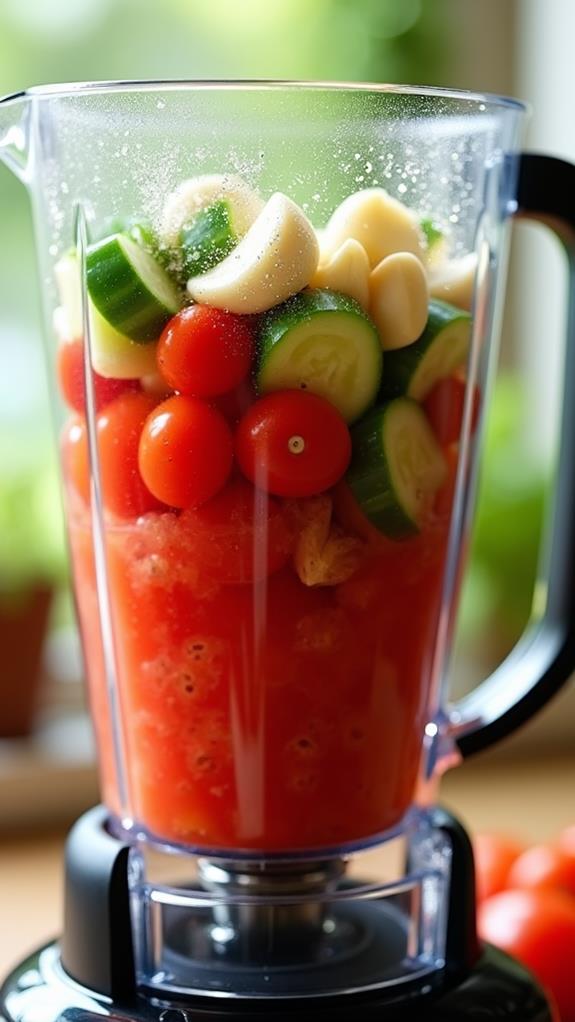
Now that your vegetables are prepped, it's time to blend everything together. Begin by adding the chopped tomatoes, cucumber, and peeled garlic cloves to your blender. Pour in the extra-virgin olive oil and sherry vinegar, ensuring all ingredients are ready for blending.
Secure the lid tightly on your blender and start at a low speed, gradually increasing to high. Blend the mixture for about 1-2 minutes, or until you've achieved a smooth consistency. If your blender struggles with the ingredients, pause occasionally to scrape down the sides with a spatula, ensuring everything's well incorporated.
Once blended, taste your gazpacho and adjust the seasoning if needed. If you prefer a silkier texture, strain the soup through a fine-mesh sieve, pressing gently with a spoon to extract all the liquid. This step removes any remaining pulp or seeds, resulting in a velvety smooth soup.
If the gazpacho seems too thick, you can thin it out by adding a little cold water or tomato juice, blending again briefly to combine. Remember, the consistency should be similar to a thick juice, easily drinkable but still substantial.
Step 3. Strain Through Fine-Mesh Sieve
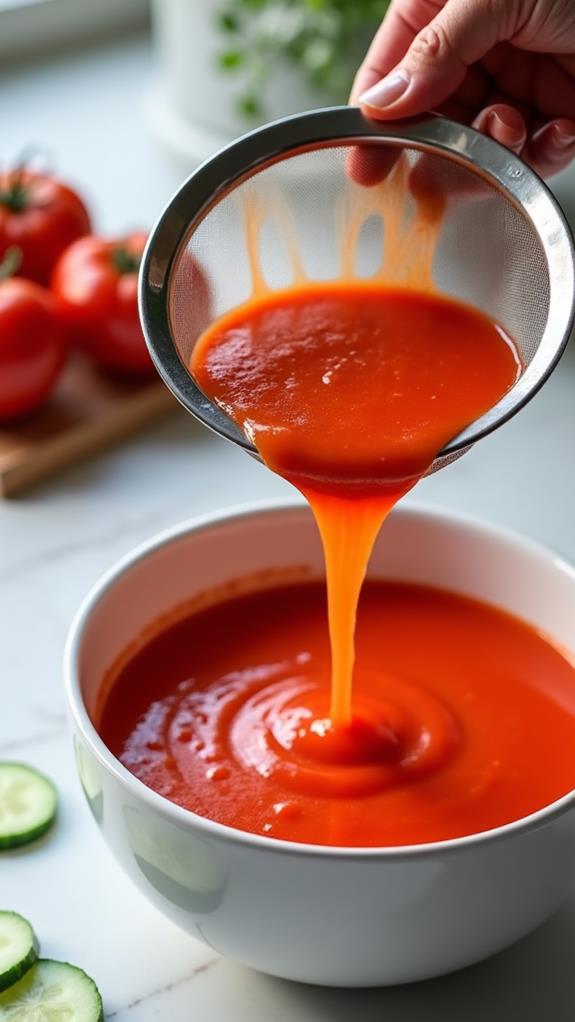
For an ultra-smooth gazpacho, you'll want to strain the blended mixture through a fine-mesh sieve. This step, while optional, can elevate your soup from good to exceptional.
Place your sieve over a large bowl and pour the blended gazpacho into it. Using the back of a ladle or a wooden spoon, gently press the mixture through the sieve. You'll notice the liquid passing through easily, while the solids remain behind.
As you work, you'll see a silky-smooth soup collecting in the bowl below. Don't rush this process; take your time to extract as much liquid as possible. The remaining solids in the sieve can be discarded or used in other recipes.
Once you've strained all the gazpacho, give it a quick stir to ensure consistency. You'll be amazed at the velvety texture you've achieved. This straining step removes any remaining seeds or fibrous bits, resulting in a refined, restaurant-quality soup.
If you find the strained gazpacho too thin, you can always blend in a few more vegetables to thicken it up.
Step 4. Chill for Two Hours
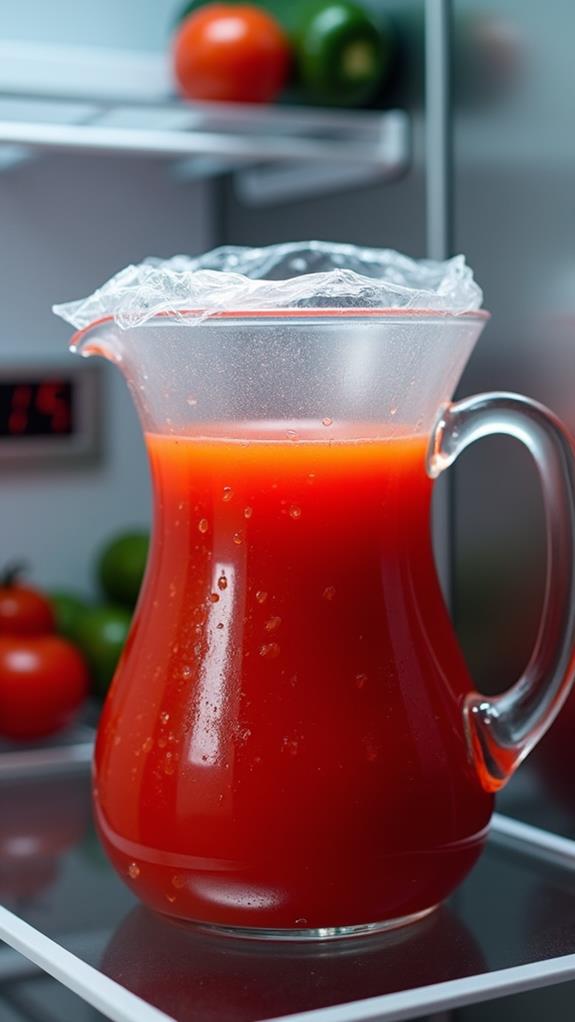
After straining your gazpacho to silky perfection, it's time to chill it properly. This step is crucial for developing the soup's flavors and achieving the refreshing temperature that makes gazpacho so appealing on hot days. Transfer your strained soup to a clean, airtight container, and place it in the refrigerator. You'll want to let it chill for at least two hours, but if you have the time, leaving it overnight will yield even better results.
During this chilling period, the flavors of the tomatoes, cucumber, garlic, and vinegar will meld together, creating a more cohesive and delicious soup. The olive oil will also slightly thicken, giving your gazpacho a smoother texture.
If you're in a hurry, you can speed up the process by placing the container in the freezer for about 30 minutes, stirring occasionally to prevent ice crystals from forming. However, be careful not to freeze the soup completely.
Once chilled, give your gazpacho a quick stir before serving to ensure all the ingredients are well combined. You'll be rewarded with a cool, flavorful soup that's perfect for beating the summer heat.
Step 5. Serve in Chilled Bowls
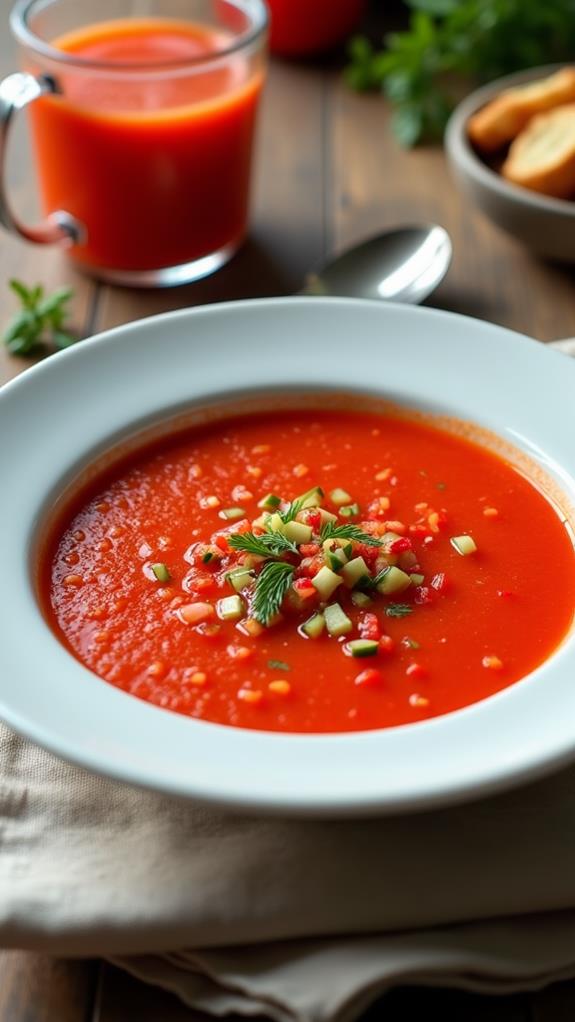
Serving gazpacho in chilled bowls elevates the dining experience and keeps the soup refreshingly cool. To achieve this, place your serving bowls in the refrigerator for at least 30 minutes before you're ready to serve. This simple step ensures that your gazpacho remains at its ideal temperature throughout the meal.
When it's time to serve, remove the chilled bowls from the refrigerator and ladle the gazpacho into them immediately. You'll notice that the cold ceramic helps maintain the soup's temperature, allowing you to savor every spoonful at its best.
For an extra touch of elegance, consider garnishing each bowl with a drizzle of high-quality olive oil, a few drops of sherry vinegar, or a sprinkle of finely diced cucumber and tomato. These additions not only enhance the visual appeal but also provide textural contrast to the smooth soup.
If you're serving gazpacho as part of a larger meal, consider offering it as a starter in smaller portions. This light and refreshing soup sets the stage for the main course while tantalizing your guests' taste buds with its vibrant flavors.
Final Thoughts
This classic gazpacho recipe is a testament to the power of simplicity in cooking. By using just five key ingredients, you're able to create a soup that's both refreshing and deeply flavorful. As you've learned, the key to success lies in selecting the ripest tomatoes and allowing the natural flavors of the vegetables to shine through.
Remember, gazpacho is incredibly versatile. You can experiment with different variations by adding ingredients like bell peppers, bread for thickening, or even watermelon for a sweet twist. Don't be afraid to adjust the seasonings to suit your taste preferences. If you find the soup too acidic, a pinch of sugar can help balance the flavors.
As you make this dish your own, keep in mind that gazpacho is more than just a soup – it's a celebration of summer's bounty.
Whether you're serving it as a light lunch, a dinner starter, or a refreshing snack, this Spanish classic is sure to impress your guests and keep you cool during hot weather.
With its make-ahead convenience and nutritional benefits, gazpacho is a dish you'll want to return to time and time again.

